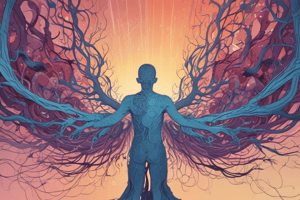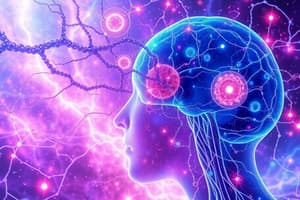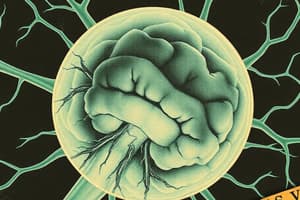Podcast
Questions and Answers
Which of the following best describes the role of dendrites in a neuron?
Which of the following best describes the role of dendrites in a neuron?
- Receiving signals from other neurons. (correct)
- Facilitating drug metabolism.
- Transmitting electrical impulses away from the cell body.
- Regulating neuronal gene expression.
The process of a drug entering the bloodstream from its administration site is known as:
The process of a drug entering the bloodstream from its administration site is known as:
- Drug metabolism
- Drug distribution
- Drug absorption (correct)
- Drug excretion
What is the primary purpose of Phase I metabolism in the context of pharmacokinetics?
What is the primary purpose of Phase I metabolism in the context of pharmacokinetics?
- Binding drugs to receptors on target cells
- Distributing drugs throughout the body.
- Modifying drugs to increase their solubility. (correct)
- Conjugating drugs to facilitate excretion.
How do G-linked proteins (GPCRs) contribute to cell signaling?
How do G-linked proteins (GPCRs) contribute to cell signaling?
What does the term 'steady state' refer to in the context of drug pharmacokinetics?
What does the term 'steady state' refer to in the context of drug pharmacokinetics?
Which of the following describes the function of an ionic filter in ion channels?
Which of the following describes the function of an ionic filter in ion channels?
In classic synaptic neurotransmission, what is the role of the presynaptic neuron?
In classic synaptic neurotransmission, what is the role of the presynaptic neuron?
Which of the following is an example of a second messenger involved in intracellular signaling?
Which of the following is an example of a second messenger involved in intracellular signaling?
During signal transduction, what is the primary role of amplification?
During signal transduction, what is the primary role of amplification?
Which mechanism directly prevents prolonged activation of a signaling pathway and maintains cellular homeostasis?
Which mechanism directly prevents prolonged activation of a signaling pathway and maintains cellular homeostasis?
A drug binds to a receptor and elicits a biological response, mimicking the effect of the natural ligand. What type of drug is this?
A drug binds to a receptor and elicits a biological response, mimicking the effect of the natural ligand. What type of drug is this?
A researcher observes that a specific gene is expressed differently based on whether it was inherited from the mother or the father. Which phenomenon is most likely responsible for this?
A researcher observes that a specific gene is expressed differently based on whether it was inherited from the mother or the father. Which phenomenon is most likely responsible for this?
Which factor influencing gene expression involves the silencing of one copy of a gene in females?
Which factor influencing gene expression involves the silencing of one copy of a gene in females?
A pharmaceutical company is developing a drug that binds to a receptor, activating it, but producing a weaker response than the natural ligand. What type of drug are they developing?
A pharmaceutical company is developing a drug that binds to a receptor, activating it, but producing a weaker response than the natural ligand. What type of drug are they developing?
Which of the following cellular responses is directly triggered by signal transduction?
Which of the following cellular responses is directly triggered by signal transduction?
A scientist is studying a signaling pathway and observes cross-talk between multiple pathways. What is the most likely outcome of this integration and modulation?
A scientist is studying a signaling pathway and observes cross-talk between multiple pathways. What is the most likely outcome of this integration and modulation?
A patient reports experiencing sleepwalking as a side effect. Which of the following medications is most likely contributing to this adverse effect?
A patient reports experiencing sleepwalking as a side effect. Which of the following medications is most likely contributing to this adverse effect?
A physician is considering prescribing a medication to help a patient both fall asleep and stay asleep throughout the night. Based on their half-lives, which of the following medications would be the MOST appropriate choice?
A physician is considering prescribing a medication to help a patient both fall asleep and stay asleep throughout the night. Based on their half-lives, which of the following medications would be the MOST appropriate choice?
A patient with narcolepsy is prescribed a medication to promote wakefulness. Which mechanism of action is MOST likely associated with the prescribed drug?
A patient with narcolepsy is prescribed a medication to promote wakefulness. Which mechanism of action is MOST likely associated with the prescribed drug?
Which of the following medications is MOST likely to cause anticholinergic side effects, such as dry mouth, blurred vision, and urinary retention, especially in elderly patients?
Which of the following medications is MOST likely to cause anticholinergic side effects, such as dry mouth, blurred vision, and urinary retention, especially in elderly patients?
A patient taking quetiapine (Seroquel) reports experiencing muscle stiffness and tremors. Which of the following side effects is the MOST likely cause of these symptoms?
A patient taking quetiapine (Seroquel) reports experiencing muscle stiffness and tremors. Which of the following side effects is the MOST likely cause of these symptoms?
A patient with depression is prescribed trazodone (Desyrel) primarily for its sedative effects to help with insomnia. Which of the following mechanisms of action is MOST responsible for this sedative effect?
A patient with depression is prescribed trazodone (Desyrel) primarily for its sedative effects to help with insomnia. Which of the following mechanisms of action is MOST responsible for this sedative effect?
A patient taking clonazepam (Klonopin) for anxiety is advised about the potential risks associated with long-term use. Which of the following is the MOST significant concern regarding the chronic use of clonazepam?
A patient taking clonazepam (Klonopin) for anxiety is advised about the potential risks associated with long-term use. Which of the following is the MOST significant concern regarding the chronic use of clonazepam?
Which of the following medications is approved for the treatment of both schizophrenia and bipolar disorder?
Which of the following medications is approved for the treatment of both schizophrenia and bipolar disorder?
A patient with impaired kidney function is prescribed a medication that is primarily eliminated through renal excretion. Which pharmacokinetic process is most likely to be affected in this patient?
A patient with impaired kidney function is prescribed a medication that is primarily eliminated through renal excretion. Which pharmacokinetic process is most likely to be affected in this patient?
In which scenario might benzodiazepines paradoxically increase the risk of seizures?
In which scenario might benzodiazepines paradoxically increase the risk of seizures?
A drug is known to have poor oral bioavailability due to significant first-pass metabolism. Which of the following strategies would likely be LEAST effective in improving its absorption?
A drug is known to have poor oral bioavailability due to significant first-pass metabolism. Which of the following strategies would likely be LEAST effective in improving its absorption?
A drug has a high affinity for plasma proteins. How would this characteristic most likely affect its distribution?
A drug has a high affinity for plasma proteins. How would this characteristic most likely affect its distribution?
Why are stimulants sometimes prescribed for individuals experiencing excessive daytime sleepiness (hypersomnia)?
Why are stimulants sometimes prescribed for individuals experiencing excessive daytime sleepiness (hypersomnia)?
What is the primary focus when using pharmacological treatments for daytime sleepiness?
What is the primary focus when using pharmacological treatments for daytime sleepiness?
A patient is taking Drug A, which is metabolized by CYP3A4. If Drug B, a CYP3A4 inhibitor, is added to the patient's regimen, what is the most likely effect on Drug A?
A patient is taking Drug A, which is metabolized by CYP3A4. If Drug B, a CYP3A4 inhibitor, is added to the patient's regimen, what is the most likely effect on Drug A?
Which of the following is a potential long-term consequence of untreated chronic insomnia?
Which of the following is a potential long-term consequence of untreated chronic insomnia?
A patient is prescribed Drug X, a substrate of CYP2C9. The patient also starts taking Drug Y, a CYP2C9 inducer. How should the dose of Drug X be adjusted and why?
A patient is prescribed Drug X, a substrate of CYP2C9. The patient also starts taking Drug Y, a CYP2C9 inducer. How should the dose of Drug X be adjusted and why?
How does chronic insomnia impact cognitive functions?
How does chronic insomnia impact cognitive functions?
A drug is administered intravenously. Which of the following pharmacokinetic phases is effectively bypassed?
A drug is administered intravenously. Which of the following pharmacokinetic phases is effectively bypassed?
Drug A is a substrate of CYP3A4. Grapefruit juice is a known CYP3A4 inhibitor. What effect would drinking grapefruit juice have on the plasma concentration of Drug A?
Drug A is a substrate of CYP3A4. Grapefruit juice is a known CYP3A4 inhibitor. What effect would drinking grapefruit juice have on the plasma concentration of Drug A?
Which of the following non-pharmacological strategies aims to address insomnia by modifying maladaptive thoughts and behaviors related to sleep?
Which of the following non-pharmacological strategies aims to address insomnia by modifying maladaptive thoughts and behaviors related to sleep?
Which non-pharmacological intervention for insomnia involves creating a sleep environment and daily routine that promotes consistent and restful sleep?
Which non-pharmacological intervention for insomnia involves creating a sleep environment and daily routine that promotes consistent and restful sleep?
If a drug's half-life is 4 hours, approximately how long will it take for the drug to be almost completely eliminated from the body (assuming first-order kinetics)?
If a drug's half-life is 4 hours, approximately how long will it take for the drug to be almost completely eliminated from the body (assuming first-order kinetics)?
What is the main goal of employing non-pharmacological strategies in the management of insomnia?
What is the main goal of employing non-pharmacological strategies in the management of insomnia?
In a G-protein-linked system, what is the immediate consequence of a ligand binding to a GPCR?
In a G-protein-linked system, what is the immediate consequence of a ligand binding to a GPCR?
Which of the following is the correct order of events in a typical G-protein-linked receptor pathway?
Which of the following is the correct order of events in a typical G-protein-linked receptor pathway?
How do hormones initiate intracellular changes within hormone-linked systems?
How do hormones initiate intracellular changes within hormone-linked systems?
What role do neurotrophic factors play in neuronal function?
What role do neurotrophic factors play in neuronal function?
Which type of receptor is typically activated by neurotrophic factors like BDNF or NGF?
Which type of receptor is typically activated by neurotrophic factors like BDNF or NGF?
How do ion-channel-linked systems alter cellular activity?
How do ion-channel-linked systems alter cellular activity?
What is a signal transduction cascade?
What is a signal transduction cascade?
A drug is designed to prevent the activation of G-proteins. At which step of the G-protein-linked receptor pathway would this drug primarily interfere?
A drug is designed to prevent the activation of G-proteins. At which step of the G-protein-linked receptor pathway would this drug primarily interfere?
Flashcards
Axon
Axon
A long projection of a neuron that transmits impulses from the cell body.
Dendrite
Dendrite
A branched extension of a neuron that receives signals from other neurons.
Neurotransmission
Neurotransmission
The release of neurotransmitters from a presynaptic neuron into a synapse to activate postsynaptic receptors.
Pharmacokinetics
Pharmacokinetics
Signup and view all the flashcards
Pharmacodynamics
Pharmacodynamics
Signup and view all the flashcards
Half-life
Half-life
Signup and view all the flashcards
Second messengers
Second messengers
Signup and view all the flashcards
G-linked proteins
G-linked proteins
Signup and view all the flashcards
Signal transduction cascade
Signal transduction cascade
Signup and view all the flashcards
G-protein-linked systems
G-protein-linked systems
Signup and view all the flashcards
Ion-channel-linked systems
Ion-channel-linked systems
Signup and view all the flashcards
Hormone-linked systems
Hormone-linked systems
Signup and view all the flashcards
Transduction cascades
Transduction cascades
Signup and view all the flashcards
Transcription factors
Transcription factors
Signup and view all the flashcards
Volume neurotransmission
Volume neurotransmission
Signup and view all the flashcards
Retrograde neurotransmission
Retrograde neurotransmission
Signup and view all the flashcards
Absorption
Absorption
Signup and view all the flashcards
Distribution
Distribution
Signup and view all the flashcards
Metabolism
Metabolism
Signup and view all the flashcards
Elimination
Elimination
Signup and view all the flashcards
CYP450 System
CYP450 System
Signup and view all the flashcards
Substrate (CYP450)
Substrate (CYP450)
Signup and view all the flashcards
Inducer (CYP450)
Inducer (CYP450)
Signup and view all the flashcards
Inhibitor (CYP450)
Inhibitor (CYP450)
Signup and view all the flashcards
Transduction
Transduction
Signup and view all the flashcards
Amplification
Amplification
Signup and view all the flashcards
Cellular Response
Cellular Response
Signup and view all the flashcards
Termination
Termination
Signup and view all the flashcards
Agonists
Agonists
Signup and view all the flashcards
Partial Agonists
Partial Agonists
Signup and view all the flashcards
Factors Influencing Gene Expression
Factors Influencing Gene Expression
Signup and view all the flashcards
Cross-talk in Signaling
Cross-talk in Signaling
Signup and view all the flashcards
Clonazepam
Clonazepam
Signup and view all the flashcards
Side effects of Clonazepam
Side effects of Clonazepam
Signup and view all the flashcards
Z drugs purpose
Z drugs purpose
Signup and view all the flashcards
Modafinil mechanism
Modafinil mechanism
Signup and view all the flashcards
Quetiapine
Quetiapine
Signup and view all the flashcards
Trazodone action
Trazodone action
Signup and view all the flashcards
Diphenhydramine purpose
Diphenhydramine purpose
Signup and view all the flashcards
Common side effects of Diphenhydramine
Common side effects of Diphenhydramine
Signup and view all the flashcards
Benzodiazepine Overuse
Benzodiazepine Overuse
Signup and view all the flashcards
Seizure Disorders and Benzodiazepines
Seizure Disorders and Benzodiazepines
Signup and view all the flashcards
Psychotropics for Insomnia
Psychotropics for Insomnia
Signup and view all the flashcards
Stimulants for Daytime Sleepiness
Stimulants for Daytime Sleepiness
Signup and view all the flashcards
Long-term Effects of Insomnia
Long-term Effects of Insomnia
Signup and view all the flashcards
CBT-I for Insomnia
CBT-I for Insomnia
Signup and view all the flashcards
Sleep Hygiene
Sleep Hygiene
Signup and view all the flashcards
Non-Pharmacologic Strategies
Non-Pharmacologic Strategies
Signup and view all the flashcards
Study Notes
Week 5 Quiz Study Guide
- Assignments: 35%
- Discussions: 10%
- Quizzes: 30% (10% each quiz)
- Final Exam: 25%
Key Concepts
- Axon: A long, slender projection of a neuron that transmits electrical impulses away from the cell body.
- Classic Synaptic Neurotransmission: Neurotransmitters released from a presynaptic neuron into a synapse to activate receptors on a postsynaptic neuron.
- Concentration-Time Curve: A graphical representation showing how the concentration of a drug changes over time in the body.
- Degradation: The breakdown of molecules (neurotransmitters or drugs) into inactive components.
- Dendrite: A branched extension of a neuron that receives signals from other neurons.
- Drug Absorption: The process of a drug entering the bloodstream from the site of administration.
- Drug Distribution: The movement of a drug from the bloodstream into tissues and organs.
- Excitation-Secretion Coupling: The process linking electrical excitation of a cell to the secretion of substances (e.g., neurotransmitters or hormones).
- G-protein-coupled receptors (GPCRs): Transmit signals from extracellular molecules to intracellular pathways.
- Half-life/Steady State: Half-life is the time it takes for a drug's concentration to decrease by half; steady state is when drug intake equals elimination, leading to a stable concentration.
- Ionic Filter: A selective structure in ion channels that allows only specific ions to pass based on their size and charge.
- Ion-gated channels: Proteins in the cell membrane that open or close in response to voltage changes or ligand binding, controlling ion flow.
- Neuronal Gene Expression: The process by which neurons regulate the production of proteins based on genetic instructions.
- Pharmacokinetics: The study of how drugs are absorbed, distributed, metabolized, and excreted by the body.
- Pharmacodynamics: The study of how drugs exert their effects on biological systems.
- Phase I Metabolism: Modification of drugs by enzymes to increase solubility.
- Phase II Metabolism: Drug conjugation with molecules to facilitate excretion.
- Second Messengers: Intracellular signaling molecules (e.g., cAMP, Ca2+) relaying signals from receptors to target cellular processes.
- Signal Transduction Cascade: A series of biochemical reactions converting an extracellular signal into a cellular response.
- Retrograde Neurotransmission: Postsynaptic neurons sending signals back to presynaptic neurons to regulate neurotransmitter release.
- Transduction Cascades: Molecular pathways relaying and amplifying cellular signals from receptors to intracellular targets.
- Transcription Factors: Proteins regulating gene expression by binding to specific DNA sequences.
- Volume Neurotransmission: Neurotransmitter diffusion beyond the synapse to influence multiple neurons in a broader area.
Key Points (Additional Information)
- Four main types of second messenger systems: G-protein-linked, ion-channel-linked, hormone-linked, and neurotropic systems.
- G-protein-linked systems: G-protein-coupled receptors (GPCRs) activating intracellular signaling via G-proteins regulating second messengers like cAMP or Ca2+.
- Ion-channel-linked systems: Ligand-gated or voltage-gated ion channels opening or closing in response to a signal, allowing specific ions (e.g., Na+, K+, Ca2+) to enter or exit the cell.
- Hormone-linked systems: Hormones binding to receptors, triggering intracellular cascades via second messengers.
- Neurotropic systems: Neurotrophic factors activating receptors to regulate neuronal survival, differentiation, and synaptic plasticity.
Studying That Suits You
Use AI to generate personalized quizzes and flashcards to suit your learning preferences.




